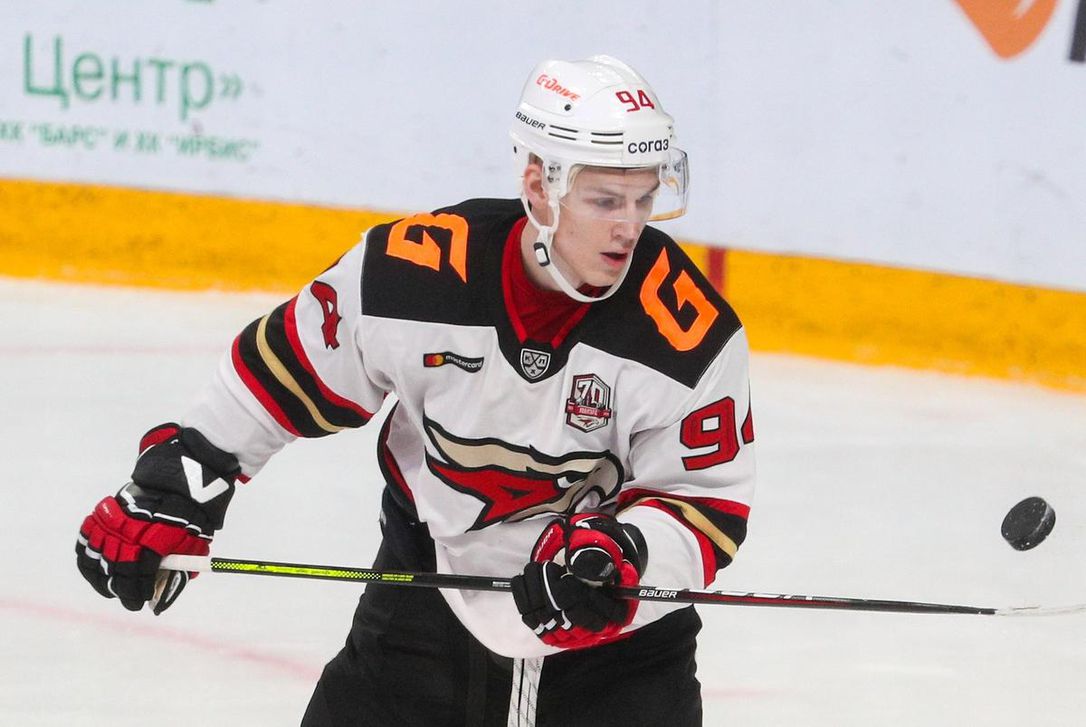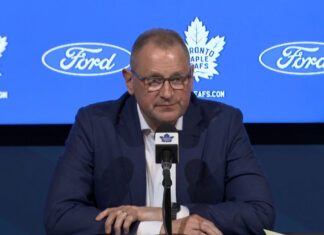On Wednesday morning, the Toronto Maple Leafs inked undrafted KHL free agent Kirill Semyonov to a one-year entry-level contract.
The 6’1, 176lb center is coming off of a KHL championship while playing a defensive role for Avangard Omsk. He put up 10 goals and 26 points in 60 regular-season games this season to go along with nine points in 23 playoff games.
🖋 We’ve signed forward Kirill Semyonov to a one year entry-level contract for the 2021-22 season. #LeafsForever
Details » https://t.co/24an8aBcig pic.twitter.com/oEe1jHphw4
— Toronto Maple Leafs (@MapleLeafs) May 5, 2021
Semyonov is a client of agent Dan Milstein, who also represents a number of prominent Russian NHL players. There is a long list of current and former Leafs that Milstein represents, including Nikita Zaitsev, Alexander Barabanov, Rodion Amirov, Artur Akhtyamov, Semyon Der-Arguchintsev, and Ilya Mikheyev.
If nothing else, this signing signals once again that the Leafs organization clearly maintains a strong relationship with Milstein and is generally well-respected by European UDFAs. They have been able to maintain this relationship by acquiring a number of these types of players, treating them well, providing them with opportunities, and shipping them off to a different organization if they cannot make it work in Toronto (e.g. Alex Barabanov, Mikko Lehtonen).
With this relationship and reputation in place, they will continue to be the favourites for a number of highly-touted UDFAs, and while not all of them work out, some will. Ilya Mikheyev, a former UDFA himself, has carved out a role as a strong depth forward/penalty kill option, and he’s a fan favourite to boot.
Will Semyonov work out and become an important contributor like Mikheyev, or will we see him shipped off to another organization for minor-league depth? Let’s dive into who Semyonov is as a player and how he projects at the NHL level.
Kirill Semyonov: Player Anaysis & Scouting Report
Semyonov projects as a solid defensive centerman who could play in a bottom six and kill penalties. The 26-year-old forward is awfully disruptive when in the defensive zone and when looking to stop the other team from transitioning in the neutral zone.
His physical tools (size + long reach), his ability to anticipate where the play is going, and his work rate make him a pretty annoying player to play against. He’s constantly shoulder-checking/scanning the ice, ensuring that he understands what is happening around him at all times.
Here’s an example:
These same attributes also help the forward provide defensive value while in the offensive zone via his ability to forecheck. Despite subpar linear skating stemming primarily from poor posture (we’ll get to that later), Semyonov’s crossovers and directional changes aren’t too much of an issue, allowing for him to sustain pressure on opposing defenders, making life a lot harder for them in transition:
Offensively, Semyonov plays a relatively simple game. He doesn’t offer a ton of deception as a puck carrier, and he rarely attacks defenders one-on-one or flashes much in the way of creativity. He is a capable passer in open ice, though, boasting strong vision, anticipation, and decent puck skills.
Off the puck in the offensive zone, Semyonov always tries to remain an outlet for his teammates. The center doesn’t attack the puck — he drifts into open space.
As a net-front presence, Semyonov follows the same principle: he doesn’t simply charge at the net/at a defender; rather, he tries to find open space. When he does engage with a defender, he’ll try to gain stick/body positioning in order to remain an option, or he’ll spin off the defender to remain in open space.
Overall, here’s what the ideal Kirill Semyonov shift looks like — solid defensive play, simple transition, and finding open space in the offensive zone:
What could hold Semyonov back — and will be the difference between whether or not he’s a replacement-level player or an actual solid fourth liner — is his skating.
Semyonov’s stride is held back by what is called “out-toeing.”
Ideally, when you are skating, you want to land your foot on the flat part of the skate blade, with your toes pointing in the direction of travel. In Semyonov’s case, due to severe internal hip rotation, he’s landing on his inside edges, with his knees pointed inwards. This limits his overall stride length and his glide potential, and as a result, he has to take way more strides to get from point A to point B in comparison to a mechanically efficient skater.
His stride is not effortless; it’s the exact opposite. Essentially, Semyonov is working harder for poor results.
I find skating inefficiencies are often a bit disguised in the KHL due to the slower pace of play. On the smaller ice and against faster, smarter opponents, Semyonov’s inefficient stride could be exposed.
What’s more, the forward is will turn 27 years old this coming October — he’s not really at an age where we’d expect him to take major strides (no pun intended) in his development.
Of course, the Leafs are well known for their ability to help develop a player’s skating, and as a result, they often sign/draft players with skating deficiencies in hopes that they can improve on them and get the most out of the player.
It doesn’t work every time, but there have been instances where this has panned out. Adam Brooks and Travis Dermott are both examples of players that have cleaned up their skating well enough to the point where it is not hampering their ability to be NHL contributors.
Alex Galchenyuk is another example. His forward stride still isn’t very good, but the Leafs have helped him improve his ability to change directions, which has helped him become a better forechecker — and they did this despite him being well past what we would consider “development age.”
We’ll see what the Leafs can do with Semyonov. He’s got a chance to be an effective depth piece.

































